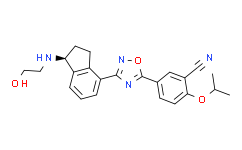Ozanimod (RPC-1063) has potency and intrinsic activity of S1P receptor modulators for S1P5 across species with [S]-GTPgS binding, and the EC50 values of 1.03 nM, 1.29 nM, 0.90 nM, 1.02 nM and 0.61 nM for Human S1P1, Cynomolgus monkey S1P1, Mouse S1P1, Rat S1P1 and Canine S1P1, respectively; and the EC50 values of 8.6 nM, 15.9 nM, 957.5 nM, 2032.7 nM and 1662.0 nM for Human S1P5, Cynomolgus monkey S1P5, Mouse S1P5, Rat S1P5 and Canine S1P5, respectively.
Ozanimod restores the potency with EC50 from 958 nM for mS1P5 to 6.7 nM for mS1P5_A120T to closely mirror the EC50 for hS1P5 of 8.6 nM by mutating the alanine in the mouse sequence.
Ozanimod has binding affinity with Ki values of 2.0 nM, 59.9 nM and 5.6 nM for hS1P5, mS1P5 and mS1P5 _A120T, respectively.
Ozanimod has saturation binding of [H]-ozanimod to hS1P5, and mS1P5_A120T with KD values of 6.56 nM, 7.35 nM, respectively and also has saturation binding for [H]-A971432 to S1P5D value of 8.75 nM.
Medlife has not independently confirmed the accuracy of these methods. They are for reference only.



 扫码关注公众号
扫码关注公众号